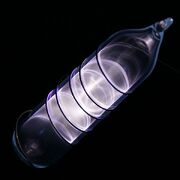
Krypton is a chemical element with the symbol Kr and atomic number 36. A colorless, odourless, tasteless noble gas, is isolated by fractionally distilling liquefied air, and is often used with other rare gases in fluorescent lamps. Krypton is inert for most practical purposes. Krypton can also form clathrates with water when atoms of it are trapped in a lattice of the water molecules.
Characteristics[]
Krypton, like the other noble gases, can be used in lighting and photography. Krypton light has a large number of spectral lines, and krypton's high light output in plasmas allows it to play an important role in many high-powered gas lasers, which pick out one of the many spectral lines to amplify. There is also a specific krypton fluoride laser. The high power and relative ease of operation of krypton discharge tubes caused (from 1960 to 1983) the official meter to be defined in terms of the orange spectral line of krypton-86.
Krypton is characterized by several sharp emission lines (spectral signatures) the strongest being green and yellow. It is one of the products of uranium fission. Solidified krypton is white and crystalline with a face-centered cubic crystal structure, which is a common property of all noble gases.
Krypton was discovered in Britain in 1898 by Sir William Ramsay, a Scottish chemist, and Morris Travers, an English chemist, in residue left from evaporating nearly all components of liquid air. Neon was discovered by a similar procedure by the same workers just a few weeks later. William Ramsay was awarded the 1904 Nobel Prize in Chemistry for discovery of a series of noble gases, including krypton. The amount of krypton in space is uncertain, as is the amount is derived from the meteoric activity and that from solar winds. The first measurements suggest an overabundance of krypton in space, which is a common property of all noble gases.
Value[]
The base value of each unit of ranges between 18 and 18Ð per unit, with up to 3 units being found at any one time.
Presence on Mars: Rare
| Martian Minerals | |
| Group 1 | Group 2 | Group 3 | Group 4 | Group 5 | Group 6 | |
| Group 2 | |Argon | Bromine | Cadmium | Gallium | Germanium | Gold | Helium III | Krypton | Molybdenum | Neon | Niobium | Nitrogen | |Palladium | Rhodium | Rubidium | Ruthenium | Scandium | Selenium | Silver | Strontium | Technetium | Titanium | Vanadium | |Yttrium | Zirconium| |